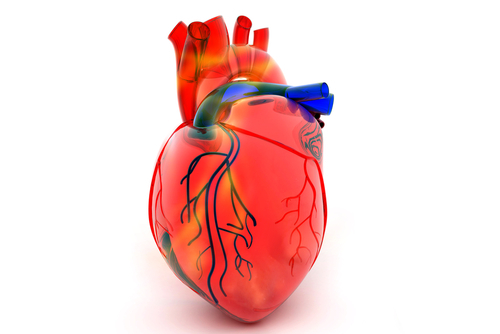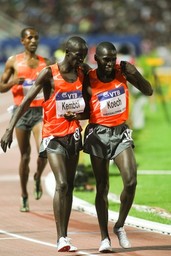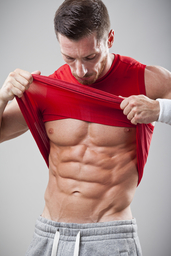5. Muscles
Contents of the chapter
5.1 Muscles
The muscles make up almost half of the body's total weight. They require a lot of energy and oxygen in order to function. Carbohydrates are the energy source that fuels muscle contraction. Muscle growth, on the other hand, requires a lot of protein.
There are three types of muscle tissue in the human body.
Cardiac muscle is involuntary, striated muscle that is found in the heart. When contracted, muscle cells produce a contraction of the heart, whereby blood is transported along the blood vessels away from the heart.
As you run, the voluntary, striated skeletal muscles contract.
Smooth muscle cells contract involuntarily. They are used to move food in the gut and blood in the veins.
Human muscles differ from an individual to another. One person may be good at exercise that requires endurance, while another person is really quick in short distance races. Speed requires strength, so fast people have stronger muscles in their legs.
5.2 Muscle cell types
5.3 Why are we good at running?
What are muscles?
5.4 Striated muscle tissue
 The cells of the striated muscles that attach to the bone are long but thin. The cells of striated muscle cells have several nuclei.
The cells of the striated muscles that attach to the bone are long but thin. The cells of striated muscle cells have several nuclei.
Striated skeletal muscles can be found everywhere in our body. They are responsible for movement. We can control the contraction of the striated muscle tissue ourselves.
Striated muscles are also called skeletal muscles, because they are attached to the tendons of bones. For example, the Achilles tendon is a tough band of fibrous tissue that connects the calf muscles to the heel bone.
The image on the right shows our largest skeletal muscles, which consist of striated, voluntary muscle cells.

A fascicle is a group of muscle fibers. The perimysium organizes the muscle fibers, which are encased in collagen and endomysium, into fascicles.
5.5 Smooth muscle tissue
The intestines, airways, blood vessels and stomach are lined with smooth muscle tissue. Smooth muscle tissue contraction is responsible for involuntary movements in the internal organs. This muscle tissue is also found around the urinary tract and in genitals.
The intestines carry chyme, whereas blood vessels carry blood. The stomach moves the chime onwards. There is no rush to do this, so smooth muscle cells work slowly.
Smooth muscle cells work involuntarily. The function of muscle cells is controlled by the autonomic nervous system. The smooth muscle cells are oval and overlap with each other. There is only one nucleus in the cells.
5.6 Cardiac muscle tissue
The cells of cardiac muscle tissue, unlike those of striated skeletal muscle, are single cells with a single nucleus. The cells of cardiac muscle tissue are branched. They are linked together into a network-like entity, so that information is rapidly transmitted to everywhere in the cardiac tissue.
The cardiac muscle pumps blood through the body and is under involuntary control. The heart and blood circulation are discussed in Chapter 9.
5.7 Adjusting muscle strength
 Striated skeletal muscles are voluntary muscles, which means that we have conscious control of their movement.
Striated skeletal muscles are voluntary muscles, which means that we have conscious control of their movement.
At the cellular level, the number of contracting cells determines the amount of force that is applied. The more the cells contract, the stronger the force they produce will be. Individual cells can either contract completely or rest.
5.8 Muscle contraction
 The process of muscle contraction begins at the behest of the brain. From the brain, the command is transmitted to the spinal cord (1), from where the command is transmitted along the motor nerve (2-3) to the surface (6) of the striated muscle cell (4), whereby the muscle contracts. Each nerve cell is linked with hundreds of muscle cells.
The process of muscle contraction begins at the behest of the brain. From the brain, the command is transmitted to the spinal cord (1), from where the command is transmitted along the motor nerve (2-3) to the surface (6) of the striated muscle cell (4), whereby the muscle contracts. Each nerve cell is linked with hundreds of muscle cells.
Explanation of the numbers in the picture: 1. spinal cord, 2. motor neuron, 3. motor neuron axon. 4. muscle cell, 5. muscle cell nucleus, 6. neuromuscular junction, 7. fascicle (a bundle of skeletal muscle fibers).
5.9 The effects of exercise on the muscular system
 There are two skeletal muscle fiber types. Red muscle is slow but durable. White muscle is fast, but gets tired very quickly. Both fiber types are present in all muscles.
There are two skeletal muscle fiber types. Red muscle is slow but durable. White muscle is fast, but gets tired very quickly. Both fiber types are present in all muscles.
Weight training increases muscle size but does not increase the number of cells. It helps small muscle cells to grow. As a result of heavy weight training, the oxygen uptake ability of a muscle can be reduced, causing a reduction in the cell's endurance properties.
In contrast, long-term training with a low resistance increases the oxygen uptake of the muscles, improving their endurance.








